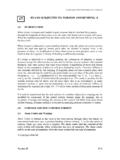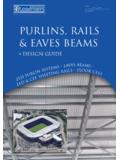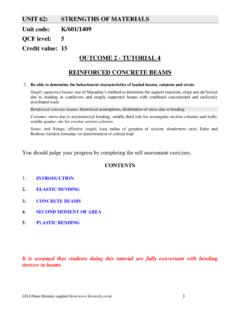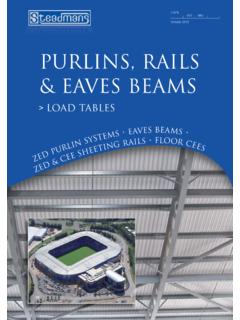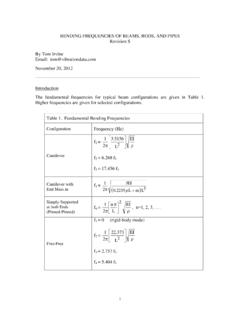Transcription of METHOD OF STRUCTURAL ANALYSIS FOR …
1 International Journal of InnovativeComputing, Information and ControlICIC Internationalc 2012 ISSN 1349-4198 Volume8, Number8, {5486 METHOD OF STRUCTURAL ANALYSIS FOR STATICALLYINDETERMINATE BEAMSA rnulfo Lu evanos RojasFacultad de Ingenieria, Ciencias y ArquitecturaUniversidad Ju arez del Estado de DurangoAv. Universidad S/N, Fracc. Filadel a, CP 35010, G omez Palacio, Durango, M April 2011; revised August paper proposes a METHOD for ANALYSIS of statically indeterminate beams,considering the shear deformations, which is an extension to the slope-de ection METHOD ,which is used to analyze all kinds of continuous beams. This methodology considersthe shear deformation and exure. The traditional METHOD takes into account only the exure deformation and without taking into account the shear deformation; this is how itusually develops STRUCTURAL ANALYSIS of statically indeterminate beams.}
2 Also, it makes acomparison between the proposed METHOD and the traditional METHOD , and the differencesbetween both methods are greater, especially members of short length as can be seen inthe results tables of the problems considered, in the traditional METHOD not all valuesare on the side of safety. Therefore, the usual practice, without considering the sheardeformations in short clear between its supports, will not be a recommended solution andit is proposed the use of considering shear deformations and also is more attached :Shear deformations, Poisson's ratio, Moment of inertia, Elasticity modulus,Shear modulus, Shear the STRUCTURAL systems ANALYSIS has been studied by diverse re-searchers in the past, making a brief historical review of progress in this 1857, Benoit Paul Emile Clapeyron presented to the French Academy his \theoremof three moments" for ANALYSIS of continuous beams, in the same way Bertot had publishedtwo years ago in the Memories of the Society of Civil Engineers of France, but withoutgiving some credit.
3 It can be said that from this moment begins the development of atrue \Theory of Structures" [1-3].In 1854, the French Engineer Jacques Antoine Charles Bresse published his book\Recherches Analytiques sur la Flexion et la R esistance de Pieces Courb es"in whichhe presented practical methods for the ANALYSIS of curved beams and arcs [1-3].In 1867, the \In uence Line" was introduced by the German Emil Winkler (1835-1888). He also made important contributions to the Resistance of materials, especially inthe exure theory of curved beams, exure of beams, resting on elastic medium [1-3].James Clerk Maxwell (1830-1879), from the University of Cambridge, published whatmight be called the rst systematic METHOD of ANALYSIS for statically indeterminate struc-tures, based on the equality of the internal energy of deformation of a loaded structure andthe external work done by applied loads, and equality had been established by Clapey-ron.
4 In his ANALYSIS presented the Theorem of the Reciprocal Deformations, which, by itsbrevity and lack of enlightenment, was not appreciated at the time. In another publica-tion later presented his diagram of internal forces to trusses, which combines in one gure54735474A. LU EVANOS ROJASall the polygons of forces. The diagram was extended by Cremona, by what is known asthe Maxwell-Cremona diagram [1-3].The Italian Betti in 1872 published a generalized form of Maxwell's theorem, known asthe reciprocal theorem of Maxwell-Betti [1-3].The German Otto Mohr (1835-1918) made great contributions to the Structures developed the METHOD for determining the de ections in beam, known as the methodof elastic loads or the conjugate beam. He also presented a simple derivation and moreextensive, which is the general METHOD of Maxwell for ANALYSIS in indeterminate structures,using the principles of virtual work.
5 He made contributions in the graphical analysisof de ections in trusses, complemented by Williot diagram, known as the Mohr-Williotdiagram of great practical utility. He also earned his famous Mohr Circle for the graphicalrepresentation of the stresses in a biaxial stress state [1-3].Alberto Castigliano (1847-1884) in 1873 introduced the principle of minimum work,which had been previously suggested by Menabrea, and is known as the First Theoremof Castigliano. Later, it presented the second Theorem of Castigliano to nd de ections,as a corollary of the rst. Published in Paris in 1879, his famous book \Th eoreme del'Equilibre de Syst emes Elastiques et ses Applications"was remarkable by its originalityand very important in the development of ANALYSIS of statically indeterminate structures[1-3].
6 Heinrich M uller-Breslau (1851-1925), published in 1886 a basic METHOD for ANALYSIS ofindeterminate structures, but was essentially a variation of those presented by Maxwelland Mohr. He gave great importance to Maxwell's Theorem of Reciprocal De ections inthe assessment of displacement. He discovered that the \in uence line" for the reactionor an inner strength of a structure was, on some scale, the elastic produced by an actionsimilar to that reaction, or inner strength. Known as the M uller-Breslau theorem, it isthe basis for other indirect methods of STRUCTURAL ANALYSIS using models [1-3].Hardy Cross (1885-1959) professor at the University of Illinois, published in 1930 hisfamous moments distribution METHOD , can be said that revolutionized the ANALYSIS ofstructures of reinforced concrete for continuous frames and can be considered one ofthe greatest contributions to the ANALYSIS from indeterminate structures.
7 This methodof successive approximations evades solving systems of equations, as presented in themethods of Mohr and Maxwell. The METHOD 's popularity declined with the availabilityof computers, with which the resolution of equations systems is no longer a problem. Thegeneral concepts of the METHOD were later extended in the study of pipes ow. Laterbecame popular methods of Kani and Takabeya also type iterative and today in disuse[1-4].In the early 50s, Turner, Clough, Martin and Topp did what may be termed as thebeginning of the implementation structures of the stiffness matrix methods, which havegained so much popularity today. Subsequently, it is developed the nite element methods,which have allowed the systematic ANALYSIS of large numbers of structures and obtain theforces and deformations in complex systems such as concrete dams used in hydroelectricplants.
8 Among its impellers are: Clough, Wilson, Zienkiewics and Gallagher [1,2,5]. STRUCTURAL ANALYSIS is the study of structures such as discrete systems. The theory of thestructures is essentially based on the fundamentals of mechanics with which are formulatedthe different STRUCTURAL elements. The laws or rules that de ne the balance and continuityof a structure can be expressed in different ways, including partial differential equationsof continuous medium three-dimensional, ordinary differential equations that de ne amember or the various theories of beams, or simply algebraic equations for a discretizedstructure. While it is deepened more in the physics of the problem, are developing theoriesthat are most appropriate for solving certain types of structures and that they demonstrateMETHOD OF STRUCTURAL ANALYSIS5475to be more useful for practical calculations.
9 However, in each new theory are doinghypotheses about how the system behaves or element. Therefore, we must always beaware of these hypotheses when evaluating solutions, the result of applying or developingtheories [6-8]. STRUCTURAL ANALYSIS can be addressed using three main approaches [9]: a) tensor for-mulations (Newtonian mechanics and vector), b) formulations based on the principles ofvirtual work, c) formulations based on classical mechanics [10].In the design of steel structures, reinforced concrete and prestressed concrete, the studyof STRUCTURAL ANALYSIS is a crucial stage in its design, since the axial forces, shear forcesand moments are those that govern the design of rigid frames and for the case of beamsonly shear forces and moments, and the damage caused by such effects may becomepredominant among the various requests to consider for your regards the conventional techniques of STRUCTURAL ANALYSIS of continuous beams, thecommon practice is to neglect the shear paper proposes to consider the shear deformations and a comparison between theproposed METHOD and the traditional METHOD is the scheme of deformation of a beam that is illustratedin Figure 1.
10 Shows the difference between the Timoshenko theory and Euler-Bernoullitheory: the rst Zy dy=dxnot necessarily coincides, while the second are equal [11].The fundamental difference between the Euler-Bernoulli theory and Timoshenko's the-ory is that in the rst the relative rotation of the section is approximated by the derivativeof vertical displacement, this is an approximation valid only for long parts in relation tothe dimensions of cross section, and then it happens that due to shear deformations arenegligible compared to the deformations caused by moment. On the Timoshenko theory,which considers the deformation due to the shear and is therefore also valid for shortbeams, the equation of the elastic curve is given by the complex system of equations:G(dydx Z)=VyAc(1)E(d Zdx)=MzIz(2)where:G= shear modulus,dy=dx= total rotation around axis \z", Z= rotationaround axis \z", due to the exure,Vy= shear force in direction \y",Ac= shear area,d Z=dx=d2y=dx2,E= elasticity modulus,Mz= moment around axis \z",Iz= momentof inertia around axis \z".
